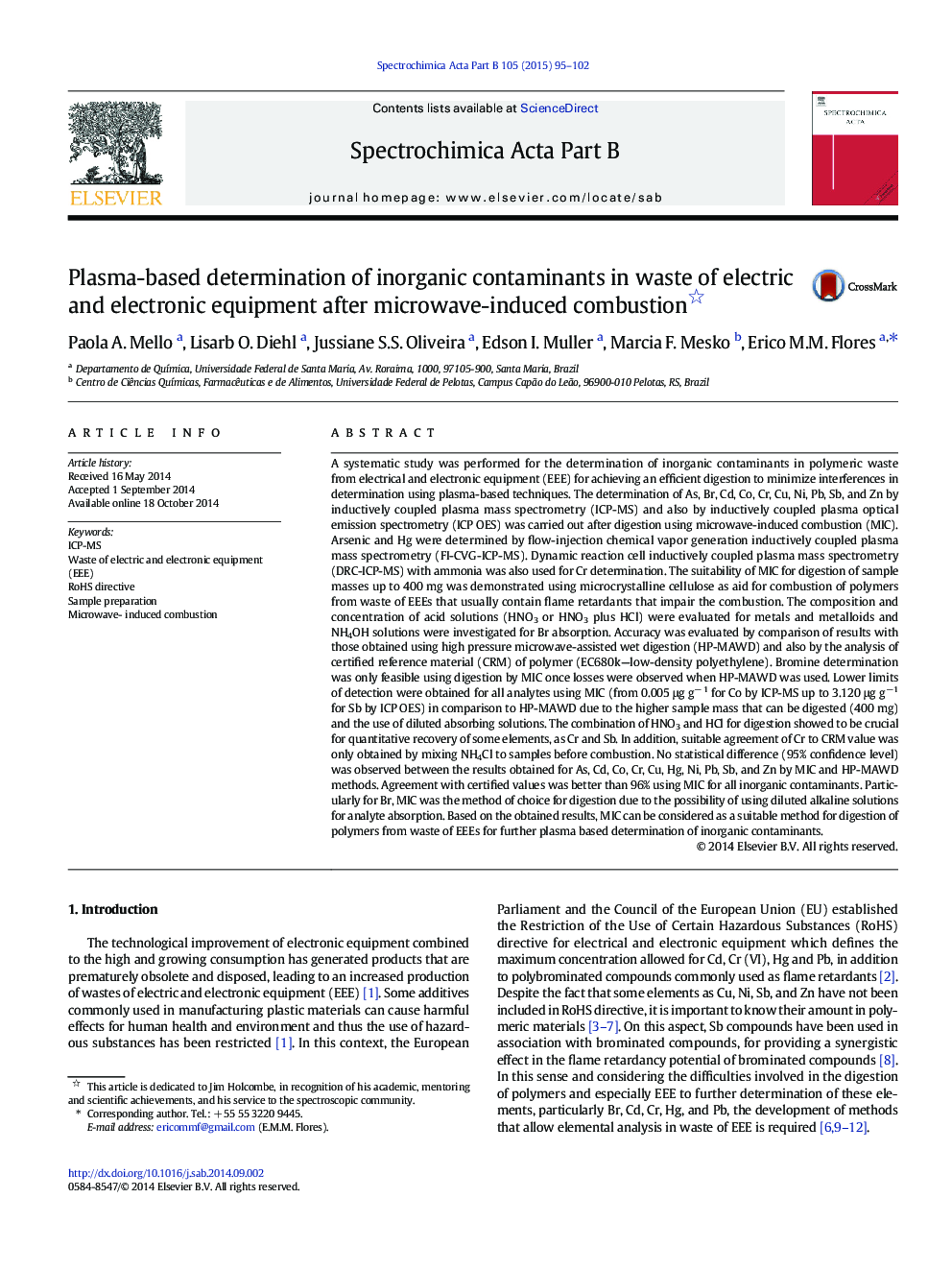| کد مقاله | کد نشریه | سال انتشار | مقاله انگلیسی | نسخه تمام متن |
|---|---|---|---|---|
| 7674336 | 1495698 | 2015 | 8 صفحه PDF | دانلود رایگان |
عنوان انگلیسی مقاله ISI
Plasma-based determination of inorganic contaminants in waste of electric and electronic equipment after microwave-induced combustion
ترجمه فارسی عنوان
تعیین پذیری آلاینده های معدنی در پساب های الکتریکی و الکترونیکی پس از احتراق ناشی از مایکروویو
دانلود مقاله + سفارش ترجمه
دانلود مقاله ISI انگلیسی
رایگان برای ایرانیان
کلمات کلیدی
موضوعات مرتبط
مهندسی و علوم پایه
شیمی
شیمی آنالیزی یا شیمی تجزیه
چکیده انگلیسی
A systematic study was performed for the determination of inorganic contaminants in polymeric waste from electrical and electronic equipment (EEE) for achieving an efficient digestion to minimize interferences in determination using plasma-based techniques. The determination of As, Br, Cd, Co, Cr, Cu, Ni, Pb, Sb, and Zn by inductively coupled plasma mass spectrometry (ICP-MS) and also by inductively coupled plasma optical emission spectrometry (ICP OES) was carried out after digestion using microwave-induced combustion (MIC). Arsenic and Hg were determined by flow-injection chemical vapor generation inductively coupled plasma mass spectrometry (FI-CVG-ICP-MS). Dynamic reaction cell inductively coupled plasma mass spectrometry (DRC-ICP-MS) with ammonia was also used for Cr determination. The suitability of MIC for digestion of sample masses up to 400 mg was demonstrated using microcrystalline cellulose as aid for combustion of polymers from waste of EEEs that usually contain flame retardants that impair the combustion. The composition and concentration of acid solutions (HNO3 or HNO3 plus HCl) were evaluated for metals and metalloids and NH4OH solutions were investigated for Br absorption. Accuracy was evaluated by comparison of results with those obtained using high pressure microwave-assisted wet digestion (HP-MAWD) and also by the analysis of certified reference material (CRM) of polymer (EC680k-low-density polyethylene). Bromine determination was only feasible using digestion by MIC once losses were observed when HP-MAWD was used. Lower limits of detection were obtained for all analytes using MIC (from 0.005 μg gâ 1 for Co by ICP-MS up to 3.120 μg g â1 for Sb by ICP OES) in comparison to HP-MAWD due to the higher sample mass that can be digested (400 mg) and the use of diluted absorbing solutions. The combination of HNO3 and HCl for digestion showed to be crucial for quantitative recovery of some elements, as Cr and Sb. In addition, suitable agreement of Cr to CRM value was only obtained by mixing NH4Cl to samples before combustion. No statistical difference (95% confidence level) was observed between the results obtained for As, Cd, Co, Cr, Cu, Hg, Ni, Pb, Sb, and Zn by MIC and HP-MAWD methods. Agreement with certified values was better than 96% using MIC for all inorganic contaminants. Particularly for Br, MIC was the method of choice for digestion due to the possibility of using diluted alkaline solutions for analyte absorption. Based on the obtained results, MIC can be considered as a suitable method for digestion of polymers from waste of EEEs for further plasma based determination of inorganic contaminants.
ناشر
Database: Elsevier - ScienceDirect (ساینس دایرکت)
Journal: Spectrochimica Acta Part B: Atomic Spectroscopy - Volume 105, 1 March 2015, Pages 95-102
Journal: Spectrochimica Acta Part B: Atomic Spectroscopy - Volume 105, 1 March 2015, Pages 95-102
نویسندگان
Paola A. Mello, Lisarb O. Diehl, Jussiane S.S. Oliveira, Edson I. Muller, Marcia F. Mesko, Erico M.M. Flores,
